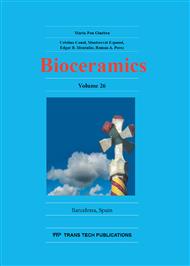p.402
p.408
p.414
p.420
p.426
p.430
p.435
p.443
p.448
Poly (L-Lactic Acid) and Hydroxyapatite Scaffold for Bone Regeneration: In Vivo Study
Abstract:
In bone tissue engineering, synthetic scaffolds are commonly used and this should present the following requirements; (i) recapitulate the native three-dimensional (3D) hierarchical fibrous structure, (ii) possess biomimetic surface properties and (iii) demonstrate mechanical integrity. However, some methods of producing scaffolds do not achieve these requirements. The present study aims the application of a composite of poly (L-lactic acid) (PLLA) and Hydroxyapatite (HA) produced by rotary jet spinning, which can be used to obtain scaffolds that meet the above requirements with affordable costs (regarding materials and production). The morphology and thermal properties of the scaffolds were characterized by scanning electron microscopy (SEM), differential scanning calorimetry (DSC), and thermogravimetric analysis (TGA). For the in vivo tests, 20 Wistar rats, distributed into two groups, in which critical defects were performed in cranial calotte were used. Then scaffolds of PLLA/HA were implanted and compared with the control group that didn’t receive the implant. The results have shown that in the cases where only the defects in cranial caps were performed, bone healing did not occur. In cases where the scaffolds of PLLA/HA were used, rich neovascularization was noted, accompanied by foreign body type reaction and presence of reactive bone around the implants. The evaluation of PLLA/HA scaffolds used in the rat calvarial defect model, according to the criteria surveyed was favorable, showed the implants insurance and that they are suitable materials to be used as substitutes of calvarial bone tissue in these animals.
Info:
Periodical:
Pages:
435-440
Citation:
Online since:
November 2014
Price:
Сopyright:
© 2015 Trans Tech Publications Ltd. All Rights Reserved
Share:
Citation:


